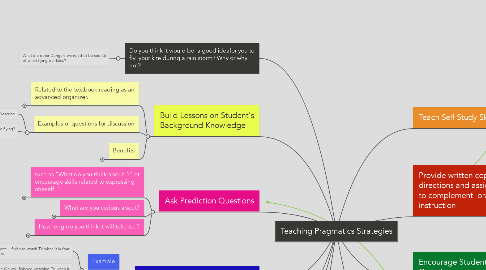
1. Do you think it would be a good ideafor you to fly your kite during a rain storm? Why or why not?
1.1. What are other Dangers we need to be careful of when flying our kites?
2. Build Lessons on Student's Background Knowledge
2.1. Related to the textbook reading as an advanced organizer.
2.1.1. Employee
2.1.2. Employee
2.2. Examples of questions for discussion
2.2.1. Have you ever flown a kite? Describe
2.2.2. What kind of weather is good for kite flying? Why?
2.3. Benefits
2.3.1. Employee
2.3.2. Employee
3. Ask Prediction Questions
3.1. such as "What do you think about..?" ot encourage skills related to expressing oneself. "
3.1.1. Employee
3.1.2. Employee
3.2. What are you curious about?
3.2.1. Employee
3.2.2. Employee
3.3. How long do you think it will take to..?
3.3.1. Employee
3.3.2. Employee
4. Encourage Students to Ask Questions
4.1. Evaluation
4.1.1. Do you agree with..
4.1.2. What is your opinion of....?
4.2. Analysis
4.2.1. Can you assess the value or importance of....?
4.2.2. Why did they choose....?
4.3. Synthesis
4.3.1. Would it have been better if.....?
4.3.2. What would you recommend?
5. Provide written copies of directions and assignments to complement oral instruction
5.1. Examples of Written Directions
5.1.1. Open Science book to page 10.
5.1.2. Read the story of "Benjamin Franklin's Kite"
5.1.3. Write five sentences that describe what happened in the story.
6. Teach Self Study Skills
6.1. Note Taking
6.1.1. Write Down key words
6.1.2. Write down unknown words
6.2. Self Questioning
6.2.1. Do I see or hear things that I know already?
6.3. Organizing
6.3.1. Organize notes in themes or categories
6.4. Test taking
7. Model Correct Language Forms
7.1. Example
7.1.1. Student: I finish to watch TV when it is four o'clock.
7.1.2. Teacher: Oh you finished watching TV when it was four oclock.
7.2. Use more pauses
7.2.1. wait for response
7.2.2. Encourage active listening feedback
8. expand your Vocabulary through out all lessons.
8.1. Use synonyms
8.2. Repeat and integrate vocabulary across all lessons.
9. Allow for Code Switching ( Mixing Languages)
9.1. Student: Vamos a comer lunch?
9.2. Teacher: Si, we are going to have lunch.
10. Use Grammar Drills
11. Practice Formalized, Structured Speaking Situations
11.1. Speeches
11.1.1. Presentations

